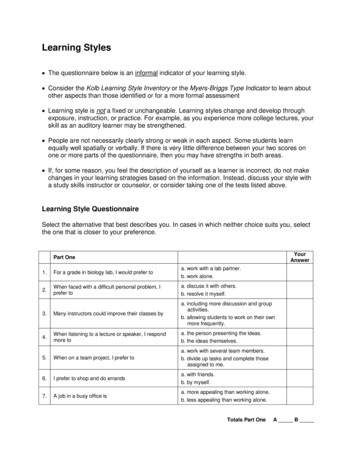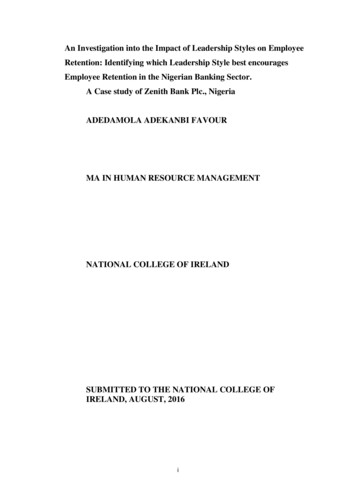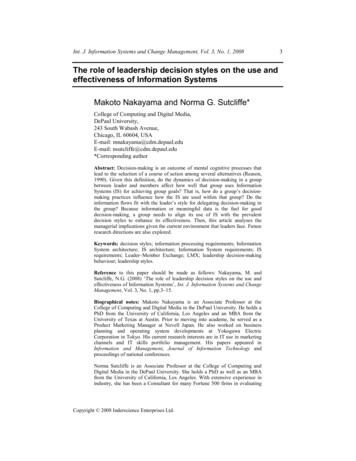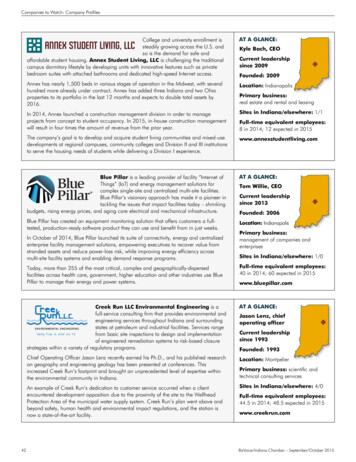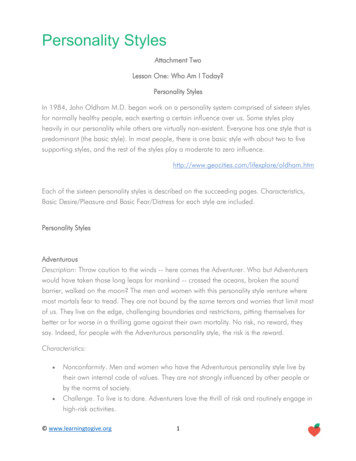
Transcription
South African Journal of Industrial Engineering November 2018 Vol 29(3) Special Edition, pp 161-172LEADERSHIP STYLES IN PROJECTS: CURRENT TRENDS AND FUTURE OPPORTUNITIESS. Pretorius1*#, H.Steyn1 & T.J. Bond-Barnard1ARTICLE INFOABSTRACTArticle detailsPresented at the 29th annual conferenceof the Southern African Institute forIndustrial Engineering (SAIIE), held from24-26 October 2018 in Stellenbosch,South AfricaCurrently, many organisations experience challenges as a result ofuncertainty, fast-changing environments, globalisation, andincreasingly complex work tasks. In order to adapt to thesechallenges, a shift in leadership style may be needed. Traditionally,leadership has been seen as a vertical relationship (top-downinfluence). For a number of decades, this vertical leadership modelhas been the principal one in the leadership field; but lately, sharedand balanced leadership have gained importance, especially in theproject management literature. This theoretical study highlightssome differences between ‘leadership’ and ‘management’, andexplores current trends in the leadership literature. It especiallyfocuses on vertical, shared, and balanced leadership in projectmanagement, and identifies future opportunities for research.Available online9 Nov 2018Contact details*Corresponding authorSuzaan.pretorius@up.ac.zaAuthor affiliations1Department of Engineering andTechnology Management,University of Pretoria, SouthAfrica#The author was enrolled for a PhD(Project Management) in theDepartment of Engineering andTechnology Management,University of Pretoria, OPSOMMINGBaie organisasies ervaar vandag uitdagings as gevolg vanonsekerheid, vinnig-veranderende omgewings, globalisering, entoenemend komplekse werkstake. ’n Verskuiwing in leierskapstylmag nodig wees om aan te pas by hierdie uitdagings. Tradisioneelwas leierskap gesien as ’n vertikale verhouding (bo-na-onderinvloed), en hierdie vertikale leierskapsmodel was die vernaamsteeen in die leierskapsveld vir baie jare. Gedeelde en gebalanseerdeleierskap het onlangs begin om belangrik te word, veral in dieprojekbestuursliteratuur. Hierdie teoretiese studie bespreeksommige verskille tussen leierskap en bestuur, en ondersoek dieonlangse rigtings in die leierskapsliteratuur. Dit fokus veral opvertikale, gedeelde, en gebalanseerde leierskap in projekbestuur,en identifiseer toekomstige geleenthede vir navorsing.INTRODUCTIONOver the past two decades, the general perception of an organisation as a ‘machine’, in whichleaders at the top of the hierarchy direct and control processes, has changed [1]. In its place, theorganisation can be seen as a dynamic system of interrelated relationships and networks ofinfluence. In order to accommodate this paradigm shift in thinking about the organisation, a changein the concept of leadership has also taken place [1].The increasing application of empowered teams, coupled with the flattening of organisationalstructures, results in the need for a shift in the more traditional models of leadership [2]. Turnerand Müller [3] demonstrate that leadership is a critical success factor for projects. Müller et al. [4]state that research on project leadership is becoming increasingly important for projectmanagement as a profession. Studies on balanced leadership are limited, and are not linked to ageneral framework that would allow scholars to theorise about it or practitioners to use itdeliberately to the advantage of their projects [5].Traditionally, leadership has been perceived as a single individual (the formally appointed leader)leading a number of subordinates or followers. This relationship has been a vertical one of top-down161
influence that could also be called ‘vertical’ leadership. For a number of decades, this leadershipmodel has been the principal one in the leadership field. Recently however, researchers havechallenged this notion [6]. New models of leadership have emerged, leading to the so-called ‘postheroic’ or shared leadership approach. The intention of this innovative approach to leadership is totransform organisational practices, structures, and interdependencies. This evolving leadershipmodel holds that effective leadership does not depend on individual, heroic leaders, but rather onleadership practices at different levels within the organisational hierarchy, as it is a group-levelphenomenon [1,4].The objective of this study is to contribute to the body of knowledge in the field of leadershippertaining to project management. This study is intended for both scholars and practitioners, as itaims to provide them with new insights into current trends in the literature pertaining to leadership— specifically, vertical and shared leadership — and future opportunities for research.2LITERATURE REVIEWWe start the literature review with a brief history of the development of leadership theory andterminology.2.1Leadership theories: A brief historyFor more than a century, ‘leadership’ has been a focus of academic introspection. Finding adefinition for the term has proved to be challenging for researchers and practitioners alike, and noconsensus has been reached [7]. Barker [8] says that everyone generally knows what leadership is,until asked to define it. The word ‘leadership’ has different meanings for different people. Modernleadership theories started to develop during the Industrial Revolution, when mainly economistsstarted paying attention to it [9]. The industrial-era leadership theories were based on thehierarchical outlook adopted by the early Christian Church, which believed that leadership wascentralised in the person at the top of the hierarchy and in that individual’s excellent qualities andabilities to manage his subordinates, as well as the activities of this person in relation to goalachievement [8].Definitions of leadership have evolved constantly during the past decade [7]. Rost [10] studiedmaterial written from 1900 to 1990, and found more than 200 different definitions for leadership. Itbecame increasingly clear to scholars that it is probably impossible to devise one common definitionof leadership, due to such factors as growing global influences and generational differences.Leadership may continue to mean different things to different people [7].Despite the diverse number of ways in which leadership has been conceptualised, there are certaincomponents that are most frequently central to the phenomenon. They are the following [7]: 2.2Leadership is a process — i.e., a transactional occurrence that takes place between leaders andfollowers. “The leader affects and is affected by followers”. Leadership is not limited to adesignated leader, but is available to everyone.Leadership encompasses influence — i.e., how the leader affects followers. It is a continuoussocial process [8].Leadership takes place in groups — i.e., a leader influences a group of individuals who have acommon purpose.Leadership involves common goals — i.e., leaders and followers have a mutual purpose.Leadership is not the property of the project manager, but instead a property of the projectitself [11].Leadership is both an individual and an institutional trait [12].Leadership approaches, theories, and stylesA number of leadership approaches, theories, and styles have featured in the literature in the pastcouple of decades. All of them have their strengths, weaknesses, and criticisms, which will not becovered in this study due to scope limitations. These approaches, theories, and styles briefly include,but are not limited to, the following:162
2.2.1 Trait approachThis methodology is built on the theory that people are born with certain traits that make themgreat leaders. The instinctive leadership talents of great social, political, and military leaders (e.g.,Abraham Lincoln, Mohandas Gandhi, and Napoleon Bonaparte) were identified and used todetermine the specific traits that separated leaders from followers [7].2.2.2 Skills approachLeadership skills are those abilities that can be acquired and developed through practice andtraining. They can be further divided into technical skills and human skills, and include problemsolving skills, social-judgement skills, and knowledge [13].2.2.3 Behavioural approachIn this approach, it is believed that leaders are responsible for shaping an environment thatempowers followers to realise specific tasks. In other words, leaders can manage their subordinates’behaviour through staging antecedents and consequences of behaviour. There is a dynamic, mutualinteraction between the leader, the follower, and the environment. Environmental factors includetechnology, organisational structure, type of task, and the size of the organisation [14].2.2.4 Situational approachHersey and Blanchard developed this approach in 1969, and it focuses on the principle that differentsituations demand different kinds of leadership. Leadership comprises both a directive and asupportive dimension, and each has to be applied in a particular situation. The core of the situationalapproach requires that leaders match their style (directive or supportive) to the competence andcommitment of the followers [7].2.2.5 Psychodynamic approachThis model uses one principal central concept, that of personality, which is defined as a constantpattern of thinking, feeling, and acting toward the environment, which also includes other people.This approach therefore concentrates on the personalities of leaders and subordinates [13].2.2.6 Path-goal theoryAccording to this theory, effective leaders influence their followers’ motivation, ability to performwell, and satisfaction. This theory focuses mainly on how the leader affects his/her followers’perception of their work, personal goals, and paths to goal realisation. The leader’s behaviour shouldincrease subordinate goal achievement and illuminate the paths to these goals [15].2.2.7 Leader-member exchange theoryThis theory focuses on the relationship between leader and follower. The leaders developindividualised relationships with each of their subordinates, and leadership becomes apparent whenleaders and followers are able to establish real interactions that result in reciprocal and incrementalinfluence [16].2.2.8 Strategic leadershipThis type of leadership focuses on how executive leaders influence organisational performance, thusaddressing leadership occurrences at the upper levels of organisations [17].2.2.9 Transformational leadershipAvolio, Walumbwa and Weber [16] define transformational leadership as “leader behaviours thattransform and inspire followers to perform beyond expectations while transcending self-interest forthe good of the organisation”. This type of leadership includes the four aspects of idealisedinfluence, inspirational motivation, intellectual motivation, and individualised attention [13]. Anexample of transformational leadership in an organisation would be a manager who tries to changehis/her company’s corporate values “to reflect a more humane standard of fairness and justice”.While doing this, both manager and subordinates may develop higher and stronger moral values [7].This leadership type is primarily people-focused [3].2.2.10 Transactional leadershipThe bulk of the leadership models can be categorised under transactional leadership, which centreson the interactions that occur between leaders and subordinates. It occurs when managers offerpromotions or financial incentives to employees who exceed their goals [7]. This leadership type islargely task-focused [3].163
2.2.11 Servant leadershipServant leaders want to serve by ensuring that their followers’ highest priority needs are beingserved. They place the good of their followers over their own self-interests, and exhibit strong moralbehaviour [7]. Servant leadership can be viewed as a trait or a behaviour [13].2.2.12 Authentic leadershipHere the main emphasis is on the leader’s genuineness (authenticity/truthfulness). The leader istransparent, and exhibits ethical behaviour that promotes openness in sharing the informationneeded to make decisions while taking followers’ contributions in consideration. Authenticleadership is collectively viewed in three diverse conducts: intrapersonal, developmental, andinterpersonal [13,16]. This leadership style centres around trust, and is motivated by the well-beingof the followers [18].2.2.13 Charismatic leadershipThis type of leadership arises in times of distress, uncertainty, or extreme enthusiasm, and exists ina range of social relationships. It is powered by emotion and the frantic commitment of followers.The charismatic leader can arise from outside of the formal organisational hierarchy, and does notneed to be an appointed leader. Charisma is seen as a talent that is innate to an individual.Charismatic leaders usually disappear suddenly once their inborn talents are no longer needed orwhen they no longer exist [19].2.2.14 Laissez-faireA laissez-faire leader typically circumvents making decisions, delegates responsibility, and does notenforce authority [3].Pearce and Wassenaar [20] are of the opinion that all the above labels are “simply the proverbialold wine in new skins”. They state that shared leadership incorporates all of these terms, and thatit provides a way to organise and make sense of them. They define ‘shared leadership’ as a metatheory of leadership, meaning that all leadership is shared leadership. It is just the degree thatdiffers: sometimes leadership is shared completely, while at other times it is not shared at all. Zhuet al. [21] say that almost any type of leadership can be shared, and that shared leadership isregarded as “meta-level leadership”. This study will use the above definition of Pearce andWassenaar [20], for whom shared leadership is seen as a form of leadership that encompasses allleadership styles, theories, and approaches. Thus leadership can be seen as a continuum betweenvertical and shared leadership, where there could be
Abraham Lincoln, Mohandas Gandhi, and Napoleon Bonaparte) were identified and used to determine the specific traits that separated leaders from followers [7]. 2.2.2 Skills approach Leadership skills are those abilities that can be acquired and developed through practice and training. They can be further divided into technical skills and human skills, and include problem-solving skills, social .
